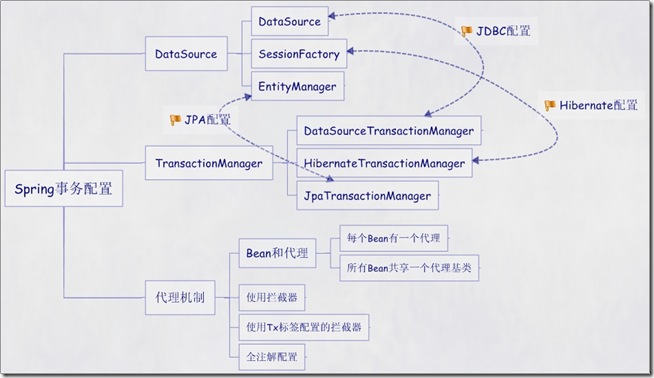(转)Spring事务配置的五种方式
前段时间对Spring的事务配置做了比较深入的研究,在此之间对Spring的事务配置虽说也配置过,但是一直没有一个清楚的认识。通过这次的学习发觉Spring的事务配置只要把思路理清,还是比较好掌握的。
总结如下:
Spring配置文件中关于事务配置总是由三个组成部分,分别是DataSource、TransactionManager和代理机制这三部分,无论哪种配置方式,一般变化的只是代理机制这部分。
DataSource、TransactionManager这两部分只是会根据数据访问方式有所变化,比如使用Hibernate进行数据访问时,DataSource实际为SessionFactory,TransactionManager的实现为HibernateTransactionManager。
具体如下图:

根据代理机制的不同,总结了五种Spring事务的配置方式,配置文件如下:
第一种方式:每个Bean都有一个代理
<beans xmlns="http://www.springframework.org/schema/beans"
xmlns:xsi="http://www.w3.org/2001/XMLSchema-instance"
xmlns:context="http://www.springframework.org/schema/context"
xmlns:aop="http://www.springframework.org/schema/aop"
xsi:schemaLocation="http://www.springframework.org/schema/beans
http://www.springframework.org/schema/beans/spring-beans-2.5.xsd
http://www.springframework.org/schema/context
http://www.springframework.org/schema/context/spring-context-2.5.xsd
http://www.springframework.org/schema/aop http://www.springframework.org/schema/aop/spring-aop-2.5.xsd">
<bean
id="sessionFactory"
class="org.springframework.orm.hibernate3.LocalSessionFactoryBean">
<property
name="configLocation" value="classpath:hibernate.cfg.xml" />
<property
name="configurationClass" value="org.hibernate.cfg.AnnotationConfiguration" />
</bean>
<!-- 定义事务管理器(声明式的事务)
-->
<bean
id="transactionManager"
class="org.springframework.orm.hibernate3.HibernateTransactionManager">
<property
name="sessionFactory" ref="sessionFactory" />
</bean>
<!-- 配置DAO
-->
<bean
id="userDaoTarget" class="com.bluesky.spring.dao.UserDaoImpl">
<property
name="sessionFactory" ref="sessionFactory" />
</bean>
<bean
id="userDao"
class="org.springframework.transaction.interceptor.TransactionProxyFactoryBean">
<!-- 配置事务管理器
-->
<property
name="transactionManager" ref="transactionManager" />
<property
name="target" ref="userDaoTarget" />
<property
name="proxyInterfaces" value="com.bluesky.spring.dao.GeneratorDao" />
<!-- 配置事务属性
-->
<property
name="transactionAttributes">
<props>
<prop
key="*">PROPAGATION_REQUIRED</prop>
</props>
</property>
</bean>
</beans>
第二种方式:所有Bean共享一个代理基类
<beans xmlns="http://www.springframework.org/schema/beans"
xmlns:xsi="http://www.w3.org/2001/XMLSchema-instance"
xmlns:context="http://www.springframework.org/schema/context"
xmlns:aop="http://www.springframework.org/schema/aop"
xsi:schemaLocation="http://www.springframework.org/schema/beans
http://www.springframework.org/schema/beans/spring-beans-2.5.xsd
http://www.springframework.org/schema/context
http://www.springframework.org/schema/context/spring-context-2.5.xsd
http://www.springframework.org/schema/aop http://www.springframework.org/schema/aop/spring-aop-2.5.xsd">
<bean
id="sessionFactory"
class="org.springframework.orm.hibernate3.LocalSessionFactoryBean">
<property
name="configLocation" value="classpath:hibernate.cfg.xml" />
<property
name="configurationClass" value="org.hibernate.cfg.AnnotationConfiguration" />
</bean>
<!-- 定义事务管理器(声明式的事务)
-->
<bean
id="transactionManager"
class="org.springframework.orm.hibernate3.HibernateTransactionManager">
<property
name="sessionFactory" ref="sessionFactory" />
</bean>
<bean
id="transactionBase"
class="org.springframework.transaction.interceptor.TransactionProxyFactoryBean"
lazy-init="true" abstract="true">
<!-- 配置事务管理器
-->
<property
name="transactionManager" ref="transactionManager" />
<!-- 配置事务属性
-->
<property
name="transactionAttributes">
<props>
<prop
key="*">PROPAGATION_REQUIRED</prop>
</props>
</property>
</bean>
<!-- 配置DAO
-->
<bean
id="userDaoTarget" class="com.bluesky.spring.dao.UserDaoImpl">
<property
name="sessionFactory" ref="sessionFactory" />
</bean>
<bean
id="userDao" parent="transactionBase" >
<property
name="target" ref="userDaoTarget" />
</bean>
</beans>
第三种方式:使用拦截器
<beans xmlns="http://www.springframework.org/schema/beans"
xmlns:xsi="http://www.w3.org/2001/XMLSchema-instance"
xmlns:context="http://www.springframework.org/schema/context"
xmlns:aop="http://www.springframework.org/schema/aop"
xsi:schemaLocation="http://www.springframework.org/schema/beans
http://www.springframework.org/schema/beans/spring-beans-2.5.xsd
http://www.springframework.org/schema/context
http://www.springframework.org/schema/context/spring-context-2.5.xsd
http://www.springframework.org/schema/aop http://www.springframework.org/schema/aop/spring-aop-2.5.xsd">
<bean
id="sessionFactory"
class="org.springframework.orm.hibernate3.LocalSessionFactoryBean">
<property
name="configLocation" value="classpath:hibernate.cfg.xml" />
<property
name="configurationClass" value="org.hibernate.cfg.AnnotationConfiguration" />
</bean>
<!-- 定义事务管理器(声明式的事务)
-->
<bean
id="transactionManager"
class="org.springframework.orm.hibernate3.HibernateTransactionManager">
<property
name="sessionFactory" ref="sessionFactory" />
</bean>
<bean
id="transactionInterceptor"
class="org.springframework.transaction.interceptor.TransactionInterceptor">
<property
name="transactionManager" ref="transactionManager" />
<!-- 配置事务属性
-->
<property
name="transactionAttributes">
<props>
<prop
key="*">PROPAGATION_REQUIRED</prop>
</props>
</property>
</bean>
<bean
class="org.springframework.aop.framework.autoproxy.BeanNameAutoProxyCreator">
<property
name="beanNames">
<list>
<value>*Dao</value>
</list>
</property>
<property
name="interceptorNames">
<list>
<value>transactionInterceptor</value>
</list>
</property>
</bean>
<!-- 配置DAO
-->
<bean
id="userDao" class="com.bluesky.spring.dao.UserDaoImpl">
<property
name="sessionFactory" ref="sessionFactory" />
</bean>
</beans>
第四种方式:使用tx标签配置的拦截器
<beans xmlns="http://www.springframework.org/schema/beans"
xmlns:xsi="http://www.w3.org/2001/XMLSchema-instance"
xmlns:context="http://www.springframework.org/schema/context"
xmlns:aop="http://www.springframework.org/schema/aop"
xmlns:tx="http://www.springframework.org/schema/tx"
xsi:schemaLocation="http://www.springframework.org/schema/beans
http://www.springframework.org/schema/beans/spring-beans-2.5.xsd
http://www.springframework.org/schema/context
http://www.springframework.org/schema/context/spring-context-2.5.xsd
http://www.springframework.org/schema/aop http://www.springframework.org/schema/aop/spring-aop-2.5.xsd
http://www.springframework.org/schema/tx http://www.springframework.org/schema/tx/spring-tx-2.5.xsd">
<context:annotation-config
/>
<context:component-scan
base-package="com.bluesky" />
<bean
id="sessionFactory"
class="org.springframework.orm.hibernate3.LocalSessionFactoryBean">
<property
name="configLocation" value="classpath:hibernate.cfg.xml" />
<property
name="configurationClass" value="org.hibernate.cfg.AnnotationConfiguration" />
</bean>
<!-- 定义事务管理器(声明式的事务)
-->
<bean
id="transactionManager"
class="org.springframework.orm.hibernate3.HibernateTransactionManager">
<property
name="sessionFactory" ref="sessionFactory" />
</bean>
<tx:advice
id="txAdvice" transaction-manager="transactionManager">
<tx:attributes>
<tx:method
name="*" propagation="REQUIRED" />
</tx:attributes>
</tx:advice>
<aop:config>
<aop:pointcut
id="interceptorPointCuts"
expression="execution(* com.bluesky.spring.dao.*.*(..))" />
<aop:advisor
advice-ref="txAdvice"
pointcut-ref="interceptorPointCuts" />
</aop:config>
</beans>
第五种方式:全注解
<beans xmlns="http://www.springframework.org/schema/beans"
xmlns:xsi="http://www.w3.org/2001/XMLSchema-instance"
xmlns:context="http://www.springframework.org/schema/context"
xmlns:aop="http://www.springframework.org/schema/aop"
xmlns:tx="http://www.springframework.org/schema/tx"
xsi:schemaLocation="http://www.springframework.org/schema/beans
http://www.springframework.org/schema/beans/spring-beans-2.5.xsd
http://www.springframework.org/schema/context
http://www.springframework.org/schema/context/spring-context-2.5.xsd
http://www.springframework.org/schema/aop http://www.springframework.org/schema/aop/spring-aop-2.5.xsd
http://www.springframework.org/schema/tx http://www.springframework.org/schema/tx/spring-tx-2.5.xsd">
<context:annotation-config
/>
<context:component-scan
base-package="com.bluesky" />
<tx:annotation-driven
transaction-manager="transactionManager"/>
<bean
id="sessionFactory"
class="org.springframework.orm.hibernate3.LocalSessionFactoryBean">
<property
name="configLocation" value="classpath:hibernate.cfg.xml" />
<property
name="configurationClass" value="org.hibernate.cfg.AnnotationConfiguration" />
</bean>
<!-- 定义事务管理器(声明式的事务)
-->
<bean
id="transactionManager"
class="org.springframework.orm.hibernate3.HibernateTransactionManager">
<property
name="sessionFactory" ref="sessionFactory" />
</bean>
</beans>
此时在DAO上需加上@Transactional注解,如下:
import java.util.List;
import org.hibernate.SessionFactory;
import org.springframework.beans.factory.annotation.Autowired;
import org.springframework.orm.hibernate3.support.HibernateDaoSupport;
import org.springframework.stereotype.Component;
import com.bluesky.spring.domain.User;
@Transactional
@Component("userDao")
public class UserDaoImpl
extends HibernateDaoSupport
implements UserDao {
public List<User> listUsers() {
return this.getSession().createQuery("from
User").list();
}

}
(转)Spring事务配置的五种方式的更多相关文章
- Spring事务配置的五种方式(转发)
Spring事务配置的五种方式(原博客地址是http://www.blogjava.net/robbie/archive/2009/04/05/264003.html)挺好的,收藏转发 前段时间对Sp ...
- Spring事务配置的五种方式和spring里面事务的传播属性和事务隔离级别
转: http://blog.csdn.net/it_man/article/details/5074371 Spring事务配置的五种方式 前段时间对Spring的事务配置做了比较深入的研究,在此之 ...
- Spring事务配置的五种方式(转载)
Spring配置文件中关于事务配置总是由三个组成部分,分别是DataSource.TransactionManager和代理机制这三部分,无论哪种配置方式,一般变化的只是代理机制这部分. DataSo ...
- Spring事务配置的五种方式
Spring配置文件中关于事务配置总是由三个组成部分,分别是DataSource.TransactionManager和代理机制这三部分,无论哪种配置方式,一般变化的只是代理机制这部分. DataSo ...
- Spring事务配置的五种方式 -- 越往后需要Spring版本越高
第五种 基本零配置 个人感觉第四种也可以 Spring配置文件中关于事务配置总是由三个组成部分,分别是DataSource.TransactionManager和代理机制这三部分,无论哪种配置方式, ...
- Spring事务配置的五种方式(转)
前段时间对Spring的事务配置做了比较深入的研究,在此之间对Spring的事务配置虽说也配置过,但是一直没有一个清楚的认识.通过这次的学习发觉Spring的事务配置只要把思路理清,还是比较好掌握的. ...
- Spring事务配置的五种方式 巨全!不看后悔,一看必懂!
前段时间对Spring的事务配置做了比较深入的研究,在此之间对Spring的事务配置虽说也配置过,但是一直没有一个清楚的认识.通过这次的学习发觉Spring的事务配置只要把思路理清,还是比较好掌握的. ...
- SSH深度历险(六) 深入浅出----- Spring事务配置的五种方式
这对时间在学习SSH中Spring架构,Spring的事务配置做了详细总结,在此之间对Spring的事务配置只是停留在听说的阶段,总结一下,整体把控,通过这次的学习发觉Spring的事务配置只要把思路 ...
- [JavaEE] Spring事务配置的五种方式
前段时间对Spring的事务配置做了比较深入的研究,在此之间对Spring的事务配置虽说也配置过,但是一直没有一个清楚的认识.通过这次的学习发觉Spring的事务配置只要把思路理清,还是比较好掌握的. ...
随机推荐
- Spring学习(24)--- AOP之 Aspect instantiation models(aspect实例模式)特别说明
重要: schema-defined aspects只支持singleton model,即 基于配置文件的aspects只支持单例模式
- JavaScript之语句,循环
JavaScript中语句主要分为三类:顺序,分支,循环. 1.顺序语句: 按照循序依次执行,最普通常见的语句,这里不多赘述. 其结构如下 2.分支语句: 根据条件判断,不同的结果执行不同的语句. 其 ...
- memcached配置
首先是安装libevent库,执行如下的命令 tar vzxf libevent-2.0.21-stable.tar.gz cd libevent-2.0.21-stable ./configure ...
- ANDROID 开发,安装离线安装包的下载地址及安装方法。
前言: 建议采用离线安装的方法安装SDK包,在线的方式实在是.....多了不解释. 下面说一下离线安装的方法: 1.下载地址:http://pan.baidu.com/s/1sjuJwYD#path= ...
- JDBC 数据库连接操作——实习第三天
今天开始了比较重量级的学习了,之前都是对于Java基础的学习和回顾.继续上篇的话题,<谁动了我的奶酪>,奉献一句我觉得比较有哲理的话:"学会自嘲了,而当人们学会自嘲,能够嘲笑自己 ...
- Linux 中最常用的目录及文件管理命令
一.查看文件的命令 对于一个文本文件,在linux中有多种查看方式来获知文件内容,如直接显示整个文本内容.分页查看内容.或者只查看文件开头或末尾的部分内容.在linux可以用不同的命令来实现. 1. ...
- Linux网络服务12——NFS共享服务
Linux网络服务12--NFS共享服务 一.NFS简介 端口号:TCP.UDP 111端口 NFS(Network File System)网络文件系统,是一种基于TCP/IP传输的网络文件系统协议 ...
- EL表达式拼接字符串
EL表达式拼接字符串<c:set var="types" value="${','}${resMap['vo'].lineType }${','}" &g ...
- Array和ArrayList的区别与联系
博主今天去了一个java的实习面试,发现有好多java最基础的数据结构对于博主来说反而感到陌生,在面试官问一些常见的例如HashMap这样的数据结构,博主能回答的头头是道,但是在问到Array和Arr ...
- word2-寻找社交新浪微博中的目标用户
项目简述: 为了进行更加精准的营销, 利用数据挖掘相关算法, 利用开放API或自行编写爬虫获得新浪微博, 知乎等社交网络(可能需要破解验证码)中用户所发布的数据, 利用数据挖掘的相关算法进行分析, 从 ...
